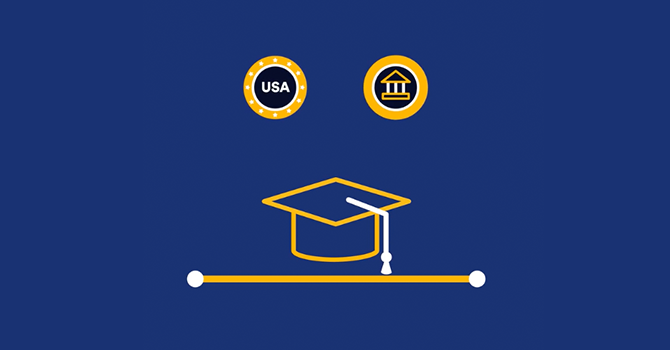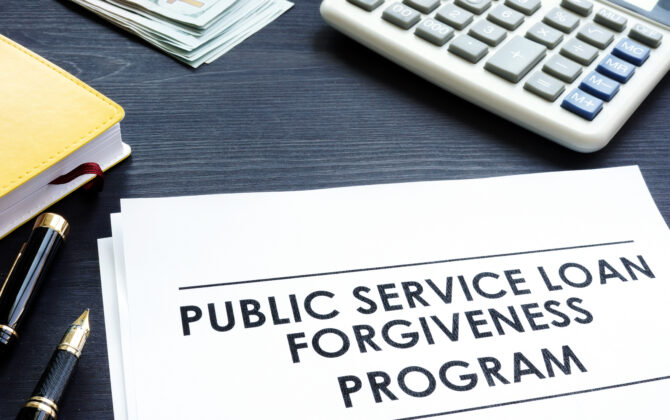When it comes to student loan repayment, there are lots of options out there. Sorting through the different ways to pay and finding the best fit for your needs may seem daunting, but taking a high-level look at the programs and plans in front of you can help you choose the right repayment plan for your situation.
Guide to Student Loan Repayment
Sorting through the different ways to pay and finding the best fit for your needs may seem daunting, but taking a high-level look at the programs and plans in front of you can help you choose the right repayment plan for your situation.


Federal or private student loans?
A borrower’s journey often begins with choosing between federal or private loans, each of which offers different student loan repayment options. All standard federal loans have fixed interest rates, where the rate stays the same for the duration of the loan. This is generally the best choice for borrowers when federal interest rates are relatively low. Federal loans can be refinanced with a private lender, which could offer different terms (such as lower rates and variable rates) for borrowers with strong credit histories. Note that if you refinance federal student loans with a private lender you will lose access to federal programs, such as Income-Driven Repayment (IDR), federal forbearance, and any other benefits offered to federal borrowers. It’s important to be informed of your options so you make the best payment management decisions. Learn more at studentaid.gov.
How to manage student loan payments
The most important thing to remember in choosing your student loan repayment strategy is that the scheduled monthly payments should not be too high nor too low – they need to match your ability to repay the debt each month. When you can pay more than your current monthly payments, you may want to think about refinancing to shorten the term of your loan, and with the same or lower interest rate, you could significantly save on interest charges.
For federal loans, if you are unable to afford the fixed monthly payments and cannot earn additional income to meet the need, your options include applying for extensions or pursuing income-driven repayment. Consolidating your student debt is another way to simplify your payments and set up rates and terms that agree with your budget. Visit studentaid.gov to read more about managing student loan debt.
Federal student loan repayment plans
Standard Repayment
The standard repayment plan involves making 120 equal payments over the span of 10 years. If you don’t select a different plan, you will be automatically placed in the standard repayment plan. Many plans that extend the payback window beyond 10 years can have lower payments. Be certain that you can afford the regular monthly payments before committing to this plan.
Extended Repayment
With the extended repayment plan, your repayment term can be extended up to 30 years. Payments will be lower than the standard repayment plan and could be fixed for the life of the loan, or be graduated, generally increasing every two years. There are minimum loan amounts to qualify for extended payment plans, and you will likely pay more interest overall.
Graduated Repayment
On a graduated repayment plan, payments start at a lower amount and increase every two years. This is a possible choice for those entering career paths where their salary or overall earnings are likely to go up over time.
Consolidation
Consolidation lumps your various federal loans into a new single federal loan with new terms. New terms can mean a lower monthly payment, but they may have a longer repayment period, which could mean paying more over the life of the loans. Read more here.
Federal student loan forgiveness options
There are several options available that may allow you to have a portion of your federal loans forgiven after meeting certain program requirements.
Income-Driven Repayment (IDR) programs
If you have a modest income and a substantial amount of debt, an IDR plan could be an excellent option. Income-driven plans set your payment amount at a percentage of your discretionary income. Go to the Federal Student Aid website at studentaid.gov/idr for the most up-to-date information on IDR plans, and explore the chart below.
IDR Comparison Chart
| Plan | Monthly Payments | Repayment Period | Status |
|---|---|---|---|
| Income-Based Repayment (IBR) |
|
20-25 years, depending on when you become a new borrower | Remains available but borrowers cannot select plan after 60 payments on REPAYE that occur on/after July 1, 2024 |
| Pay as You Earn (PAYE) |
|
20 years | Not accepting new enrollments as of July 2023 |
| SAVE (formerly REPAYE) |
|
|
This plan replaces REPAYE |
| Income-Contingent Repayment (ICR) |
The lesser of the following:
|
25 years | Not accepting enrollments for current students; only available to future borrowers with consolidated Parent PLUS loans |
Public Service Loan Forgiveness (PSLF)
Borrowers working in public or non-profit sector jobs could have loans forgiven after 10 years of service. If you are employed in certain public service jobs, such as at a not-for-profit hospital, and have made at least 120 payments on your direct loans, the remaining balance may be forgiven.1 The Federal Student Aid website offers further information and guidance around PSLF and eligibility. Also read more in our Guide to Federal Student Loan Repayment Programs, where you can learn how to schedule a free counseling session with our PSLF specialists.
Private student loan refinancing options
Student loan refinancing is a way to get a new loan, and a new, potentially lower rate, through a private lender. It is not exactly the same as consolidation, which can be done through federal loans. While federal consolidation can help someone combine multiple loans into one, refinancing provides other specific benefits, like the opportunity to:
Lower your interest rate
A private lender may offer a lower rate than federal rates, especially for those with excellent credit.
Lower your monthly payments
A borrower might opt to lower their monthly payments if it becomes necessary—though this may raise the interest or increase the amount of time it takes to pay off the loan, it could be the best option when the borrower’s financial situation requires it.
Change from fixed rate to variable rate or vice versa
A borrower’s preference for fixed vs. variable rate can change depending on employment and financial situation.
Pay off your loans quicker
Shortening the loan term may allow a borrower to pay less interest as the debt is paid off faster through higher monthly payments.
Save money over the life of the loan
By paying off the loan faster or switching to a fixed interest rate, a borrower may pay less total interest over the life of the loan.
Note that if you refinance federal student loans with a private lender, you will lose access to federal programs, such as Income-Driven Repayment (IDR), federal forbearance, and any other benefits offered to federal borrowers. Learn more at studentaid.gov.
Fixed vs. variable terms for refinancing
After you decide on a term, the other major factor is whether a loan is fixed or variable. While a fixed rate stays constant over the life of a loan, the variable rate option offers lower initial rates. However, these rates can fluctuate as interest rates change, which is hard to predict. Variable-rate loans are good for people who believe they will make enough money in the future to cover potentially higher payments if rates go up but may not be good for people whose future income is unpredictable.
Refinancing terms are ultimately determined by each lender. Those who are in good financial standing, demonstrate a strong career trajectory, have good credit scores, and have shown they are responsible managing their debt are more likely to be approved. Some private lenders, such as Laurel Road, may also consider your professional career stage and career trajectory when evaluating your financial situation.
To determine the right student loan repayment plan for you, reach out for a free consultation with one of our student loan specialists.
A final option: forbearance
College graduates with federal student loans who are experiencing hardships may have the option to forbear, or not make payments on their student loans for up to 36 months over the life of their loan. However, during forbearance, the interest on both subsidized and unsubsidized loans is accruing and capitalizes once the forbearance period is over. As a result, borrowers accrue more interest in each subsequent time that they utilize forbearance and the loans start to snowball. If you can’t meet any of the other options, forbearance is a possibility, but it is generally recommended to pursue IDR instead (you may even qualify for IDR with a zero monthly payment to start). Visit the Federal Student Aid website for a comprehensive overview of terms and qualifications, and other available hardship options.
Choosing the right student loan repayment plan
Borrowers can take advantage of different programs available to them to maximize savings on student loan repayment, whether federal or private. Plus, there are many resources with advice and guidance on how to make repaying student loans simpler and less stressful.
Laurel Road offers several options based on your individual financial situation, whether you need to speak with one of our GradFin student loan specialists2 to consider PSLF or IDR and other federal repayment plans, or to see if refinancing is right for you — we can help.
Don’t miss the latest financial resources.
This site is protected by reCAPTCHA and the Google Privacy Policy and Terms of Service apply.
Get tailored Laurel Road resources delivered to your inbox.
Search Results


